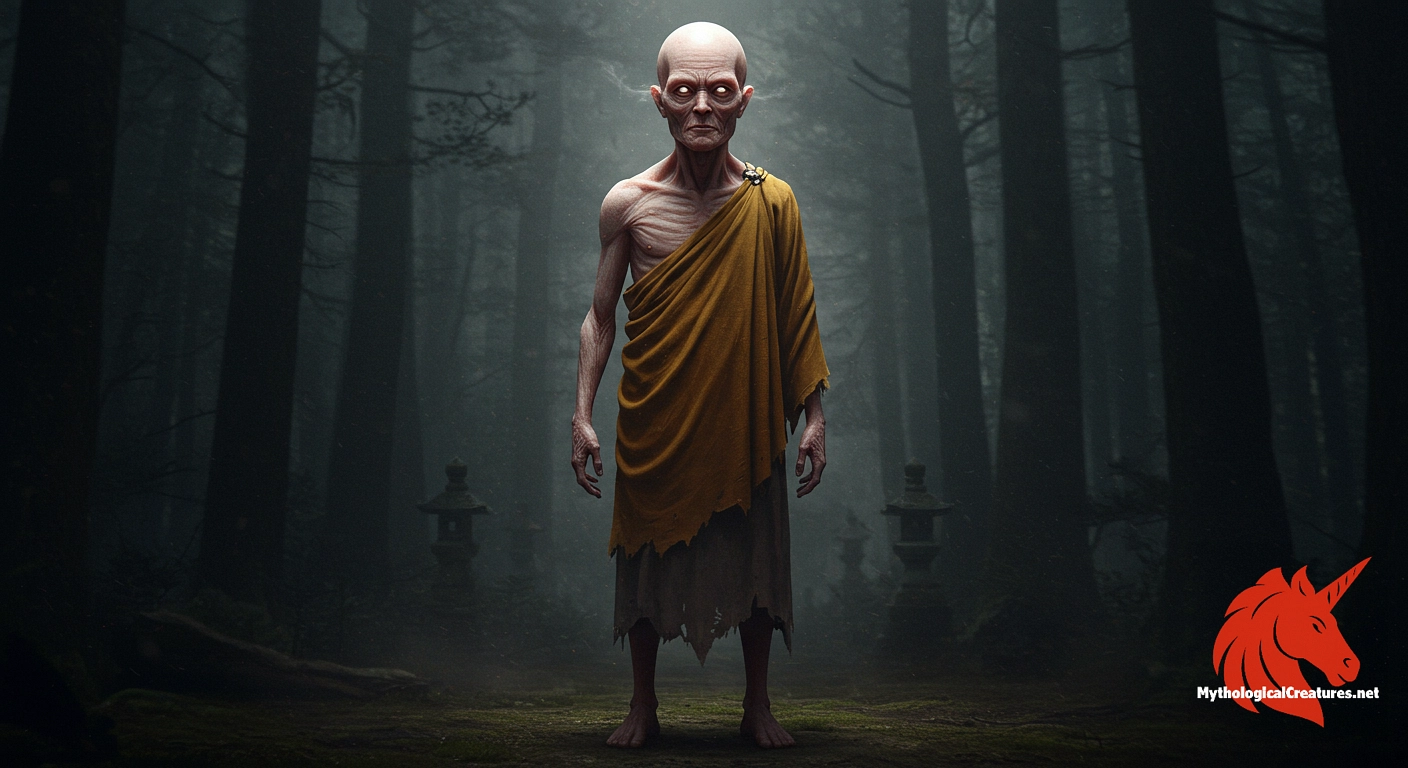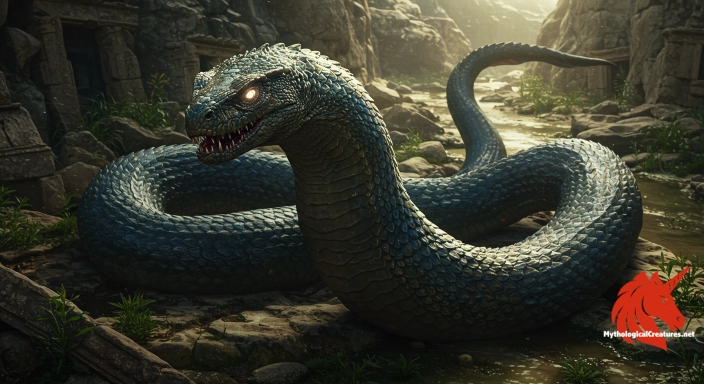Ōnyūdō: Ōnyūdō is a Japanese yōkai known for its large, imposing appearance and monk-like form.

Ōnyūdō
Ōnyūdō - Represents the mysterious, transformative aspects of the supernatural in Japanese culture.
Origins & First Encounters
Ōnyūdō has long been enveloped in an air of mystery, its origin deeply embedded within the rich soil of Japanese folklore. This supernatural figure, often associated with the visage of a large monk, presents a complex character that straddles the line between benevolence and mischief. Its tales have been passed down through generations, each narrative adding layers to its enigmatic identity. The early mentions of Ōnyūdō can be traced back to periods when oral tradition and illustrated manuscripts played a pivotal role in everyday life. Its presence in the folkloric canon can be seen as a reflection of a society grappling with the unknown and the ineffable. The creature’s ambiguous nature provided a symbolic explanation for the inexplicable events that punctuated daily life in historical Japan. The lore surrounding Ōnyūdō has continued to evolve as it moved from secluded village storytelling to more widespread literary and artistic depictions. Its enduring legacy captures the tension between revered tradition and an ever-changing cultural landscape, cementing its place as a compelling figure within the mythic heritage of Japan. Its persona remains a testament to a time when the supernatural was a constant companion to the mundane, and its story offers both caution and wonder.
Source Texts & Tale Variants
Ancient texts and pictorial scrolls from the Edo period first set the stage for the Ōnyūdō legend, serving as key sources for its multifaceted portrayals. Various kaidan anthologies and collections of yōkai lore soon followed, each adding its own twist to the creature’s narrative. In some chronicles, Ōnyūdō is recounted not merely as a fearsome apparition, but as a spectral wanderer whose presence signals deeper, more inscrutable forces at work in the human realm. Diverse folklore sources have recounted encounters where the creature either aids or admonishes those it meets, lending it a dualistic nature. Compendia of supernatural beings, including those compiled by artists and authors of the period, have enriched its story with details of its mysterious habits and shifting demeanour. Oral traditions, preserved and modified through local storytelling, further contributed to the creature's layered mythos. These narratives, varying from one region to another, highlight the adaptability of its character across different cultural landscapes. The multiplicity of sources emphasises a common theme found in folklore—the evolution of a myth through continuous reinterpretation and adaptation. Each new retelling has added subtle nuances, ensuring that Ōnyūdō remains as unpredictable as the folklore itself. The interweaving of written and oral records solidifies its status as an emblematic figure in Japanese supernatural lore.
Form & Powers
The physical manifestation of Ōnyūdō is as striking as it is ambiguous, often depicted with imposing dimensions that defy conventional human anatomy. Traditionally, it appears as a towering, monk-like figure with a smooth, bald head that exudes an almost unearthly glow under dim light. Its features are a blend of human and inhuman, with eyes that seem to harbour unfathomable depths and an expression that shifts between serenity and menace. Robes reminiscent of those worn by Buddhist monks frequently cloak its muscular or sometimes ethereal form, adding to the aura of both sanctity and foreboding. The details of its appearance vary markedly between accounts; some traditions describe elongated limbs and hands that taper into claw-like appendages, while others focus on the robust, almost sculptural build of the creature. The interplay of light and shadow in artistic renditions highlights subtle, spectral qualities that hint at a life beyond the physical realm. In certain depictions, hints of other supernatural traits—such as a faint luminescence or an aura that distorts the surrounding space—are noted, creating an unsettling yet captivating presence. The creature’s size is portrayed inconsistently, sometimes as a gargantuan silhouette dwarfing nearby structures, and other times as appears only marginally larger than an ordinary person but imbued with menacing power. Such visual contrasts and inconsistencies have helped fuel an enduring fascination with its form, making each encounter with Ōnyūdō a study in the unpredictable nature of myth.
Regional Faces
Across the varied landscape of Japan, regional folklore has adapted the image of Ōnyūdō to reflect local customs and environmental influences. In mountainous regions, the creature is often envisaged as a solitary guardian of ancient trails and secluded shrines, suggesting a protective role amid the wild terrain. Coastal villages, by contrast, recount sightings along fog-bound docks and abandoned temples, where the creature’s form is imbued with a mysterious, almost aquatic shimmer. In the northern reaches, where the cold imbues legends with a harsher tone, Ōnyūdō is sometimes portrayed as a spectral harbinger of the season’s harsh transitions. Urban legends in the heartland, meanwhile, recast its narrative as a metaphor for the internal turmoil and labyrinthine complexities of modern society. These diverse portrayals underscore the adaptability of Ōnyūdō, with local storytellers refining its character to resonate with regional beliefs and superstitions. Some local adaptations even paint the being in a less malevolent light, positioning it as a solemn guide during times of personal or communal crisis. The regional diversity in the Ōnyūdō folklore mirrors the broader Japanese tendency to personalise supernatural encounters, thereby creating a rich tapestry of cultural narratives. Such variations ensure that while the core myth remains recognisable, each rendition offers a unique insight into the values and historical context of its community.
Cultural Parallels
The myth of Ōnyūdō is part of a wider global dialogue on supernatural entities, finding resonances with similar figures in cultures far beyond Japan. In East Asian traditions, comparable figures such as spectral monks and ghostly hermits often traverse the boundaries between the earthly and the divine, echoing the duality found in Ōnyūdō. European folklore, with its own pantheon of wandering spirits and enigmatic apparitions, offers a parallel in the form of the robed, hooded figures that haunt ancient abbeys and desolate roads. The creature’s ambiguous moral nature, simultaneously protective and ominous, aligns it with the archetypal trickster or liminal being seen across multiple cultural mythologies. These cross-cultural comparisons highlight a universal human fascination with beings that challenge the clear-cut demarcations between good and evil. The ability of Ōnyūdō to inspire both dread and reverence is shared by many supernatural figures that act as mirrors to society’s hidden fears and desires. While the specific iconography may differ—the Japanese yōkai drawing on Buddhist and indigenous spiritual elements, for instance—the underlying themes of transformation and the disruption of natural order are remarkably similar. Such comparative insights not only enrich our understanding of individual myths but also reveal how different cultures utilise the supernatural to navigate life’s uncertainties and complexities. Throughout varying traditions, the motif of a mysterious wanderer continues to captivate imaginations, reinforcing the idea that legends are as varied as they are universal.
Legacy & Modern Evolution
The evolution of Ōnyūdō from a whispered village tale to a prominent figure in modern media illustrates the dynamic life of folklore. Originally rooted in the enigmatic traditions of pre-modern Japan, its representation was bound by the local customs and superstitions of its era. With the advent of the Edo period, illustrative works and textual compilations amplified its presence, cementing its role in the cultural imagination. In contemporary times, the creature has experienced a renaissance, with artists, filmmakers, and writers reinterpreting its legend for a modern audience. This evolution is marked by a shift from purely frightful narratives to more nuanced depictions that explore themes of identity, transformation, and the coexistence of tradition with modernity. The symbolic weight of Ōnyūdō is now frequently invoked in discussions about the clash between urban life and ancient spirituality. Digital art, comic books, and even thematic exhibits have embraced its mysterious allure, ensuring that its myth remains vibrant and relevant. Modern reinterpretations often serve as a bridge that connects Japan’s storied past with its contemporary cultural landscape, encouraging new dialogues around age-old mystical themes. The legacy of Ōnyūdō is a compelling reminder of how myth adapts and endures, continually reflecting the transformative nature of cultural belief systems.
Interesting Fact
Ōnyūdō's fluctuating appearance and ambiguous behavior have been interpreted as a metaphor for the transient nature of life and spirituality in Japanese culture, highlighting the interplay between fear and fascination in folklore.
Quick Creature Info
Our Mythic Legendary Rating:

Also Sometimes Known As:
Habitat:
Supernatural Powers:
Physical Attributes:
Abilities:
Behavior:
Weaknesses:
Lore:
Related Creatures, Tales or Lore
References
Discover Another Mythical Legend You May Not Have Heard Of?
Uncover the mysteries of ancient folklore and expand your knowledge of legendary beings from cultures around the world.
Dare to Meet the Illuyanka....
Curated by the Mythological Creatures Team (rev. May 2025)
